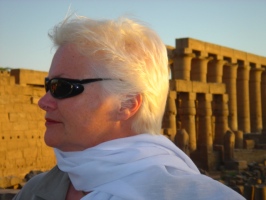I was a small girl in California when I’d first heard of the ichthyosaurs. My mother had read me Isabel Frances Bellous’s poem “The Ichthyosaurus.”
There once was an ichthyosaurus,
Who lived when the earth was all porous,
Be he fainted with shame
When he first heard his name,
And departed a long time before us.
My mother might have mentioned that Mary Anning—who hunted for fossils and the world’s first ichthyosaur skeleton—lived on a beach like I did. She might have mentioned that Mary had tremendous energy and intellect, yet wasn’t taken seriously. I remember the black-and-white sketch of an ichthyosaur illustrating the poem.

The memory of that poem and Tracy Chevalier’s historical fiction book, Remarkable Creatures, had now led me to spend a week in Weymouth, a slightly faded seaside resort on the Jurassic Coast in west Dorset. From there, I then took the X53 bus from King George’s Statue station and traveled 95 miles northwest along Chesil Beach to Lyme Regis. Among other sites, Lyme Regis is where you find The Cobb, a walkable, serpentine breakwater harbor wall poking out into Lyme Bay, one bay west from Weymouth Bay on the English Channel. The Cobb was made famous in Jane Austen’s book Persuasion, where Captain Wentworth and Anne Elliott go walking. The Cobb wall is also where Meryl Streep’s French Lieutenant’s woman character does some fashionably mysterious turns in her heavy, chocolate-colored cloak. But to me it is perhaps most famous as the setting for Mary Anning’s ichthyosaur finds.
I had waited for a sunny day to make my visit, even though I knew that Mary had never been a fair-weather paleontologist. She had in fact made many of her most important finds after winter storms. In 2001, UNESCO listed the “Jurassic Coast” along Dorset and East Devon beaches, cliffs, and headland, one of the most significant Earth Science sites in the world. It is the United Kingdom’s only natural World Heritage site, and the only place in the world where 185 million years of geology in a near-continuous sequence are revealed in the limestone-and-mudstone cliffs. A walk along the coast is like walking through the Triassic, Jurassic, and Cetaceous periods.
Captain Wentworth and Anne care for Louisa, who had just impulsively jumped from the Cobb, calling out “Catch me!”
Mary Anning (May 21, 1799–March 9, 1847, from breast cancer) was a British fossil collector, dealer, and paleontologist, who became known around the world for important finds in the Jurassic marine fossil beds at Lyme Regis. She contributed to fundamental changes in scientific thinking about prehistoric life and the history of the Earth. Her birth home is now a museum.
In the area’s layered Blue Lias cliffs, Mary Anning searched for fossils and skeletons. When landslides exposed new fossils, they had to be collected quickly before they were washed out to sea. As it still is today, this was dangerous work, and she nearly lost her life in 1833 during a landslide that killed her loyal dog, Tray. Walking the cliffs today, you are still confronted with detours, cautionary signs, and roped-off areas, protecting the intrepid from landslips and cave-ins.
Mary’s discoveries included the first ichthyosaur skeleton correctly identified, which she and her brother Joseph had found when she was twelve years old. (He found the skull; she found the torso.) Named ichthyosaur (“fish lizard” in Greek), it is neither a fish nor a lizard, but a marine reptile. They also found the first two plesiosaurs and the first pterosaur skeleton located outside Bavaria, Germany, plus important fish fossils. She helped confirm that coprolites (a trace fossil and originally confused with gastrointestinal “bezoar stones”) were in fact fossilized feces, since they were so often found in fossils’ lower intestines and excretory tracts. Bezoar stones are found only in the stomach. She also discovered that fossils of belemnites (extinct squid-like creatures) contained ink sacs like those of modern cephalopods.
It was a thrill to walk in Mary’s house, view down the coastline where she had searched for paleontological treasures and see the workmen repairing the coastline from the 2013-2014 winter storms: a dangerous place during Mary’s time and still dangerous today.

Post a Comment